
The Theatre Royal closes - 1962
Page added 12th December 2010
Back to Photo Essays
The last days of the Theatre Royal - Dick Passmore
In 1953 the Theatre Royal made a loss for the first time (as far as is known, as some papers were lost during the War years). In that year it lost £1,698. But the following year that loss had risen to a staggering £4,922. (Amazing when you know that just five years earlier the Theatre profits had amounted to £2,822).
Somehow there was some confusion over the accounts, as in November 1962, after the Theatre had physically closed, the Chairman of the Directors, Sir Leonard Costello, claimed that “no profit had been made since 1953”. However, the annual report of the Directors for 1957 states that the Directors were pleased to announce a profit of £1,410 – the first profit since 1953. The following year the Directors also noted a profit of £2,314 after the cost of re-seating the circle in the sum of £1,405. So, here we have a discrepancy.
However, in June 1959 the accounts again showed a loss, this time in the sum of £1,016. In 1960 the loss was the highest ever, at an unbelievable £6,500, but in 1961 that loss was reduced to just £1,400. At that time, the weekly cost of simply running the Theatre was around £400, but it was claimed that the Company could not generate that sort of money on a regular basis. It was therefore decided that “in fairness to the Company shareholders” the Theatre Royal should be sold. In July 1962, a resolution was passed at an Extra-Ordinary meeting of the shareholders to the effect that they “empowered the Directors to negotiate the sale of all the assets of the Exeter Theatre Company at the most advantageous terms”.
As early as 1959 Cliff Gwilliam, the Theatre manager, had sought a valuation of the theatre from an estate agent in, for unknown reasons, Newton Abbot. Now why go to Newton Abbot when Exeter had a plethora of estate agents who knew far more about local values, and several shareholders were prominent businessmen in the city? No sum has ever been revealed, but at first the Directors denied knowledge of Gwilliam’s action, but later, under pressure from shareholders, admitted that they has asked the Manager to make “discreet and tentative enquiries” as to the Theatre’s value. One of their reasons for selling was that as the Theatre was making a loss, they could not continue trading as an insolvent Company.
Following the decision to sell, several enquiries were made from businesses who wished to purchase the premises and either keep it as a theatre, or combine it as a theatre/ cinema. Cliff Gwilliam even maintained that he had been contacted by a London impresario who wished to purchase the theatre as a going concern and continue running it as a provincial theatre. For some reason, Gwilliam refused to name the person or the possible purchase price – and indeed this offer was never taken any further, and is not mentioned in the Director’s reports. The most suitable offer, however, was from local benefactor George Northcott, who lived at Nutwell Court, Lympstone. A wealthy man, he offered one or two options to the Directors. Having already set up a Trust for the benefit of the Arts in Devon, Northcott appointed representatives to engage in dialogue with the Theatre Directors (Northcott being unable to do so himself on the advice of doctors). He wanted to set up the Theatre Royal as a theatre and cultural centre, but his offers were not accepted by the Directors. His final offer was to inject a total of £100,000 – £42,000 for the building and the remainder to renovate it and turn it into his theatre/arts centre. This offer was rejected, but an offer of £85,000 from The Prudential Assurance Company was accepted! Although the Prudential offer was for less, after debts had been paid, it left a larger sum for distribution to the shareholders rather than keep live theatre at the Theatre Royal. It is, of course, interesting to note that at no stage did Exeter City Council take up the challenge – as several other councils have managed to do elsewhere – and buy the local theatre for the city. Instead, councillors shamefully buried their heads in the sand until the storm had blown over, and the theatre sold.
Twinkle, the Clarkson Rose family show, had been seen in Exeter on many occasions, and was always a popular week. Cliff Gwilliam arranged for that show to be at Exeter for the 1962 summer season, opening on 10th July, in the hope of attracting more people to the theatre. Sadly his hopes were dashed, and although the show was here for several weeks, some of the matinées had more in the cast than in the audience – and that is a fact. One matinée had just over twenty people in the audience.
The directors met on 30th August and decided to close the theatre. On 22nd September 1962, the run of Twinkle came to an end, as did The Theatre Royal. The citizens of Exeter had lost a much-loved building, although it has to be said that they did not, perhaps, support it as they should have done. Or was it the case that the shows put on were not to their taste. Could it possibly have survived? Could it have been better managed? Were the shareholders looking after their own interests rather than those of the citizens of Exeter? Who knows?
George Northcott decided to invest his £100,000 alongside the Gulbenkian Foundation, in forming The Northcott Theatre, a long way out of Exeter city centre, on the University campus. That theatre has had a chequered history since 1967, and has come close to closing. Recently it went into administration, but was “saved” by the University who purchased the building and all the fixtures and fittings at a ridiculously low price. Having already owned the site, the University now owned the building as well. Exeter Northcott, as it is now named, survives on funding by various bodies including local councils and The Arts Council. The latter has already called into question the way the theatre has been run, requiring it to appeal to a more diverse part of the community. However, the Arts Council themselves are facing cut-backs in its Government funding, and it is not difficult to see how they are going to continue – simply by cutting back on the grants given to bodies such as The Exeter Northcott. Thus it could be that Exeter is on the brink of losing its theatre once again – and the likes of Plymouth, Torquay and even Bristol will benefit.
Purchase Dick Passmore's The Story of the Theatre Royal Exeter (Mint Press ISBN 9781903356210) from W H Smith and Waterstones.
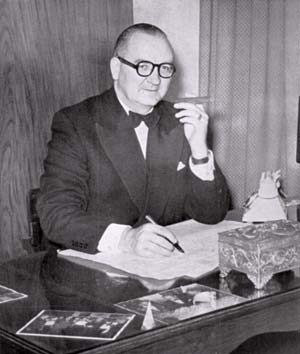 Cliff Gwilliam, the manager of the Theatre Royal.
Cliff Gwilliam, the manager of the Theatre Royal.  Clarkson Rose who devised, starred in and produced Twinkle.
Clarkson Rose who devised, starred in and produced Twinkle.
"TWINKLE"
What an excellent name for such an excellent show. This is the show 'with the lot'! I first saw it when I was soldiering during the war–in fact, it was probably this show that enthused me with the desire for a theatrical career.
Since those days, 'Clarkie' has become a dear friend, and indeed from time to time has given me a 'leg up' by supplying me with gags from his enormous store of comedy material.
I raise my 'cap' to the Theatre Royal, to "Twinkle" and, of course, to dear 'Clarkie' and Olive.
NORMAN WISDOM
from the Twinkle programme
Please click on a photo to enlarge
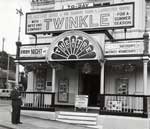 Cliff Gwilliam the manager of the Theatre Royal stands outside the theatre looking at the billboards for the last show. Photo Express and Echo.
Cliff Gwilliam the manager of the Theatre Royal stands outside the theatre looking at the billboards for the last show. Photo Express and Echo.
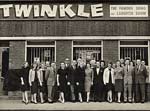 The company of Twinkle pose for a group photograph. Clarkson Rose is the gent with horn rimmed glasses in the back row. Photo Alan Hodkinson.
The company of Twinkle pose for a group photograph. Clarkson Rose is the gent with horn rimmed glasses in the back row. Photo Alan Hodkinson.
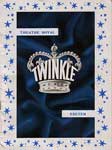 The last show at the Theatre Royal was Clarkson Rose's Twinkle. It was devised and first staged by Rose in 1921 at Ryde Pier on the Isle of Wight. It was a summer show that mostly toured the seaside resorts.
The last show at the Theatre Royal was Clarkson Rose's Twinkle. It was devised and first staged by Rose in 1921 at Ryde Pier on the Isle of Wight. It was a summer show that mostly toured the seaside resorts.
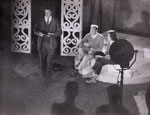 Alan Hodkinson (stage name Alan Clark) the stage manager seated, and two other members of the production stand in for a lighting check for Westward TV that was filming a report on the closing of the theatre. Photo Alan Hodkinson.
Alan Hodkinson (stage name Alan Clark) the stage manager seated, and two other members of the production stand in for a lighting check for Westward TV that was filming a report on the closing of the theatre. Photo Alan Hodkinson.
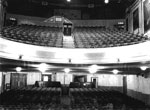 The auditorium of the Theatre Royal just before it finally closed. Photo Dick Passmore.
The auditorium of the Theatre Royal just before it finally closed. Photo Dick Passmore.
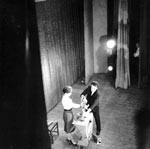 Frankie Holmes of the cast performing a magicians trick between scene changes – the 'volunteer' from the audience was a plant from the backstage crew.. Photo Dick Passmore.
Frankie Holmes of the cast performing a magicians trick between scene changes – the 'volunteer' from the audience was a plant from the backstage crew.. Photo Dick Passmore.
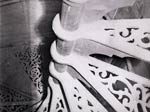 A close up of one of the cast iron spiral staircases in the theatre. Photo Alan Hodkinson.
A close up of one of the cast iron spiral staircases in the theatre. Photo Alan Hodkinson.
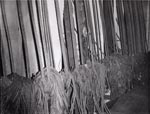 The ropes for the Theatre Royal fly system. A complex web of ropes and pulleys were used to lift and lower scenery, close the curtains and generally move scenery around the stage. Photo Alan Hodkinson.
The ropes for the Theatre Royal fly system. A complex web of ropes and pulleys were used to lift and lower scenery, close the curtains and generally move scenery around the stage. Photo Alan Hodkinson.
 The lighting switchboard was located in the wings. The last chief electrician and projectionist at the theatre was Harry Hopkins. Photo Alan Hodkinson
The lighting switchboard was located in the wings. The last chief electrician and projectionist at the theatre was Harry Hopkins. Photo Alan Hodkinson
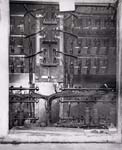 The
rear of the lighting switchboard. Photo Alan Hodkinson.
The
rear of the lighting switchboard. Photo Alan Hodkinson.
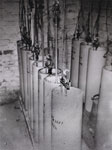 These cylinders were filled with salt water and part of the system to dim the lights – copper plates were lowered into the cylinder, with the amount of dimming determined by the length of the plate submerged in the water. Alan Hodkinson recalled how they had to top them up with more salt water when they became inefficient during the run of Twinkle. Photo Alan Hodkinson.
These cylinders were filled with salt water and part of the system to dim the lights – copper plates were lowered into the cylinder, with the amount of dimming determined by the length of the plate submerged in the water. Alan Hodkinson recalled how they had to top them up with more salt water when they became inefficient during the run of Twinkle. Photo Alan Hodkinson.
 A large Closed sign and For Sale notice appeared on the front of the theatre after Twinkle was performed for the last time on Saturday 22nd September 1962. Photo Express and Echo.
A large Closed sign and For Sale notice appeared on the front of the theatre after Twinkle was performed for the last time on Saturday 22nd September 1962. Photo Express and Echo.
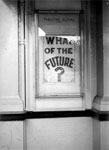 The boxoffice has closed for the last time – someone has left a cryptic message 'What of the future?' at the loss of live theatre in the city.
The boxoffice has closed for the last time – someone has left a cryptic message 'What of the future?' at the loss of live theatre in the city.
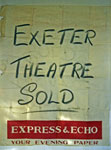 The Express and Echo's placard announcing that the theatre had been sold in November 1962 to the Prudential Assurance Company. Courtesy of Dick Passmore.
The Express and Echo's placard announcing that the theatre had been sold in November 1962 to the Prudential Assurance Company. Courtesy of Dick Passmore.
 Sanders and Redfern's poster listing some of the items that were to be auctioned on the 21st November 1962 – included were the theatre's Westar Cinemascope projectors, a Bechstein baby grand piano and 900 tip seats. Courtesy of Dick Passmore.
Sanders and Redfern's poster listing some of the items that were to be auctioned on the 21st November 1962 – included were the theatre's Westar Cinemascope projectors, a Bechstein baby grand piano and 900 tip seats. Courtesy of Dick Passmore.
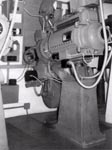 The Westar Cinemascope projector was installed in 1954 to allow the Theatre to compete with the local cinemas. After signing an agreement to show 20th Century Fox Cinemascope films, the Robe was the first to be shownin 1954. The projection equipment was sold at auction in November 1962. Photo Dick Passmore.
The Westar Cinemascope projector was installed in 1954 to allow the Theatre to compete with the local cinemas. After signing an agreement to show 20th Century Fox Cinemascope films, the Robe was the first to be shownin 1954. The projection equipment was sold at auction in November 1962. Photo Dick Passmore.
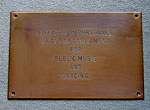
 Two items of memorabilia from the Theatre Royal. The brass licence plaque for music and dancing, left, and a fireaxe that was kept backstage for emergency use.
Two items of memorabilia from the Theatre Royal. The brass licence plaque for music and dancing, left, and a fireaxe that was kept backstage for emergency use.
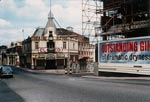 A rare colour photo of the Theatre Royal just as the demolition crew have started taking the roof apart. The partly constructed Debenhams is on the right. Photo Aubone Braddon.
A rare colour photo of the Theatre Royal just as the demolition crew have started taking the roof apart. The partly constructed Debenhams is on the right. Photo Aubone Braddon.
│ Top of Page │